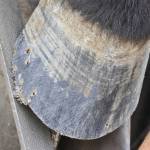Care of Quarter Cracks in Horses

Quarter cracks (cracks on the sides of hooves) are common in horses, especially racehorses and other equines in hard training and performance. The cracks may be small and shallow, or so long and deep that they cause serious lameness.
A quarter crack may be caused by a variety of factors such as damage to the coronary band, excessive loading of an unbalanced hoof, limb conformation faults, improper shoeing, or issues with the placement of the coffin bone inside the hoof.
The first step in treating and healing a quarter crack is determining why the crack appeared. Radiographs can reveal the position of the coffin bone, which may be naturally tipped slightly toward the inside or outside of the hoof. Other conformational faults such as an offset or crooked leg can be seen without radiographs. Severe coronary band injuries may disrupt hoof growth in the area of the wound, leaving the hoof weak and subject to cracking. Shoes that don’t properly support the heel can be diagnosed by a competent farrier.
Treatment is aimed at keeping the horse sound in the short term, and healing the crack and preventing its return in the longer term. Consultation between a farrier and a veterinarian may be necessary to determine the best way to manage a quarter crack in a particular horse, taking into account conformation, shoeing history, and severity of the crack.
Stabilizing the crack to keep it from moving or widening is crucial in helping the horse regain soundness. Wiring, patches, hoof fillers, or glue may be used in various combinations. The horse may be shod with a bar shoe that has a rocker or rolled toe for support and to spread pressure to other parts of the hoof. Owners should ask the farrier about a trimming and resetting schedule that will facilitate healing.
Management to prevent the return of a quarter crack depends on removing or accommodating the condition that led to the development of the crack. Consult with your veterinarian and farrier to see what management steps will help the hoof stay healthy after the crack heals.
Proper general nutrition should provide everything necessary for the horse to produce strong, resilient hoof tissue. A fortified feed should contain biotin, methionine, sulfur, and other nutrients needed for hoof health. Horses that are at risk for cracks, either because of heavy exercise or conformational issues, may benefit from a hoof supplement to ensure an adequate supply of these building blocks. For horses that need a higher level of hoof-related nutrients, Kentucky Equine Research offers Bio-Bloom PS (Bio-Bloom HF in Australia) to provide additional support for hoof quality and growth.
No one has found a way to make hooves grow faster, and it often takes twelve months to grow out a crack completely. In the worst cracks, where hoof damage is severe and there may be an infected wound at the coronary band, the horse may need an extended period of rest as healing takes place. Owners may be able to avoid this downtime by using fortified feeds, staying with a regular schedule of farrier care, and managing cracks as soon as they are noticed instead of allowing them to become worse.








